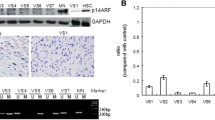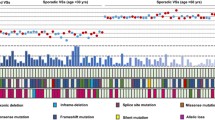Abstract
Sporadic vestibular schwannomas are benign tumors originating from the Schwann cells of the vestibular portion of the eigth cranial nerve. An important clinical hallmark of these tumors is their variable growth rate. Investigating vestibular schwannoma biology can help to clarify this variable growth rate and may offer targets for therapeutic treatment. A recent mutation analysis on sporadic non-head and neck schwannomas detected BRAF mutations in around 20 % of tumors. BRAF is part of the mitogen-activated protein kinase (MAPK)/extracellular signal-regulated kinase (ERK) pathway. MAPK/ERK activation is associated with an uncontrolled cell growth. Mutated BRAF can function as a target to inhibit this pathway. Mutations in BRAF and other members of the MAPK/ERK pathway have not been investigated in sporadic vestibular schwannomas before. The goal of this study was to investigate if these mutations are present in vestibular schwannomas and whether these mutations correlate with tumor growth. Tumor specimens of 48 patients surgically treated for a sporadic vestibular schwannoma were analyzed. An allele-specific quantitative real-time PCR assay was performed to detect the 13 most frequent mutations affecting BRAF, EGFR, PIK3CA, and KRAS. Radiologically measured tumor growth was included in the analysis to identify potential relationships between these mutations and tumor progression. No activating hotspot mutations in BRAF, EGFR, PIK3CA, or KRAS were detected. The 13 most frequent mutations affecting BRAF, EGFR, PIK3CA, and KRAS are not involved in sporadic vestibular schwannoma development. These results are in contrast to the recent detection of these BRAF mutations in non-head and neck schwannomas.

Similar content being viewed by others
References
Mautner VF, Nguyen R, Kutta H et al (2010) Bevacizumab induces regression of vestibular schwannomas in patients with neurofibromatosis type 2. Neuro Oncol 12:14–18
Seizinger BR, Martuza RL, Gusella JF (1986) Loss of genes on chromosome 22 in tumorigenesis of human acoustic neuroma. Nature 322:644–647
Rouleau GA, Merel P, Lutchman M et al (1993) Alteration in a new gene encoding a putative membrane-organizing protein causes neuro-fibromatosis type 2. Nature 363:515–521
Trofatter JA, MacCollin MM, Rutter JL et al (1993) A novel moesin-, ezrin-, radixin-like gene is a candidate for the neurofibromatosis 2 tumor suppressor. Cell 72:791–800
Golovnina K, Blinov A, Akhmametyeva EM et al (2005) Evolution and origin of merlin, the product of the neurofibromatosis type 2 (NF2) tumor-suppressor gene. BMC Evol Biol 5:69
Aarhus M, Bruland O, Saetran HA et al (2010) Global gene expression profiling and tissue microarray reveal novel candidate genes and down-regulation of the tumor suppressor gene CAV1 in sporadic vestibular schwannomas. Neurosurgery 67:998–1019
Irving RM, Moffat DA, Hardy DG et al (1994) Somatic NF2 gene mutations in familial and non-familial vestibular schwannoma. Hum Mol Genet 3:347–350
Jacoby LB, MacCollin M, Barone R et al (1996) Frequency and distribution of NF2 mutations in schwannomas. Genes Chromosomes Cancer 17:45–55
Sainz J, Huynh DP, Figueroa K et al (1994) Mutations of the neurofibromatosis type 2 gene and lack of the gene product in vestibular schwannomas. Hum Mol Genet 3:885–891
Lekanne Deprez RH, Bianchi AB, Groen NA et al (1994) Frequent NF2 gene transcript mutations in sporadic meningiomas and vestibular schwannomas. Am J Hum Genet 54:1022–1029
Hadfield KD, Smith MJ, Urquhart JE et al (2010) Rates of loss of heterozygosity and mitotic recombination in NF2 schwannomas, sporadic vestibular schwannomas and schwannomatosis schwannomas. Oncogene 29:6216–6221
Gutmann DH, Giordano MJ, Fishback AS et al (1997) Loss of merlin expression in sporadic meningiomas, ependymomas and schwannomas. Neurology 49:267–270
Hitotsumatsu T, Iwaki T, Kitamoto T et al (1997) Expression of neurofibromatosis 2 protein in human brain tumors: an immunohistochemical study. Acta Neuropathol 93:225–232
Huynh DP, Mautner V, Baser ME et al (1997) Immunohistochemical detection of schwannomin and neurofibromin in vestibular schwannomas, ependymomas and meningiomas. J Neuropathol Exp Neurol 56:382–390
Kino T, Takeshima H, Nakao M et al (2001) Identification of the cis-acting region in the NF2 gene promoter as a potential target for mutation and methylation-dependent silencing in schwannoma. Genes Cells 6:441–454
Kullar PJ, Pearson DM, Malley DS et al (2010) CpG island hypermethylation of the neurofibromatosis type 2 (NF2) gene is rare in sporadic vestibular schwannomas. Neuropathol Appl Neurobiol 36:505–514
Serrano C, Simonetti S, Hernandez J et al (2010) BRAF V600E mutations in benign and malignant peripheral nerve sheath tumors. J Clin Oncol 28:15s (abstract)
Schindler G, Capper D, Meyer J et al (2011) Analysis of BRAF V600E mutation in 1,320 nervous system tumors reveals high mutation frequencies in pleomorphic xanthoastrocytoma, ganglioglioma and extra-cerebellar pilocytic astrocytoma. Acta Neuropathol 121:397–405
Dahiya S, Yu J, Kaul A et al (2012) Novel BRAF alteration in a sporadic pilocytic astrocytoma. Case Report Med 2012:418672
Lin A, Rodriguez FJ, Karajannis MA et al (2012) BRAF alterations in primary glial and glioneuronal neoplasms of the central nervous system with identification of 2 novel KIAA1549:BRAF fusion variants. J Neuropathol Exp Neurol 71:66–72
Basto D, Trovisco V, Lopes JM et al (2005) Mutation analysis of B-RAF gene in human gliomas. Acta Neuropathol 109:207–210
Jeuken J, van den Broecke C, Gijsen S et al (2007) RAS/RAF pathway activation in gliomas: the result of copy number gains rather than activating mutations. Acta Neuropathol 114:121–133
Perrone F, Da RL, Orsenigo M et al (2009) PDGFRA, PDGFRB, EGFR, and downstream signaling activation in malignant peripheral nerve sheath tumor. Neuro Oncol 11:725–736
Fraenzer JT, Pan H, Minimo L Jr et al (2003) Overexpression of the NF2 gene inhibits schwannoma cell proliferation through promoting PDGFR degradation. Int J Oncol 23:1493–1500
Morrison H, Sperka T, Manent J et al (2007) Merlin/neurofibromatosis type 2 suppresses growth by inhibiting the activation of Ras and Rac. Cancer Res 67:520–527
Lim JY, Kim H, Kim YH et al (2003) Merlin suppresses the SRE-dependent transcription by inhibiting the activation of Ras-ERK pathway. Biochem Biophys Res Commun 302:238–245
Chadee DN, Xu D, Hung G et al (2006) Mixed-lineage kinase 3 regulates B-Raf through maintenance of the B-Raf/Raf-1 complex and inhibition by the NF2 tumor suppressor protein. Proc Natl Acad Sci USA 103:4463–4468
Zhou L, Hanemann CO (2012) Merlin, a multi-suppressor from cell membrane to the nucleus. FEBS Lett 586:1403–1408
Davies H, Bignell GR, Cox C et al (2002) Mutations of the BRAF gene in human cancer. Nature 417:949–954
Peyssonnaux C, Eychene A (2001) The Raf/MEK/ERK pathway: new concepts of activation. Biol Cell 93:53–62
McCubrey JA, Steelman LS, Chappell WH et al (2007) Roles of the Raf/MEK/ERK pathway in cell growth, malignant transformation and drug resistance. Biochim Biophys Acta 1773:1263–1284
Garnett MJ, Marais R (2004) Guilty as charged: B-RAF is a human oncogene. Cancer Cell 6:313–319
Montagut C, Settleman J (2009) Targeting the RAF-MEK-ERK pathway in cancer therapy. Cancer Lett 283:125–134
Fiirgaard B, Pedersen CB, Lundorf E (1997) The size of acoustic neuromas: CT and MRI. Neuroradiology 39:599–601
van Eijk R, Licht J, Schrumpf M et al (2011) Rapid KRAS, EGFR, BRAF and PIK3CA mutation analysis of fine needle aspirates from non-small-cell lung cancer using allele-specific qPCR. PLoS One 6:e17791
Saldanha G, Purnell D, Fletcher A et al (2004) High BRAF mutation frequency does not characterize all melanocytic tumor types. Int J Cancer 111:705–710
Ladanyi M, Pao W (2008) Lung adenocarcinoma: guiding EGFR-targeted therapy and beyond. Mod Pathol 21(Suppl 2):S16–S22
Jancik S, Drabek J, Radzioch D et al (2010) Clinical relevance of KRAS in human cancers. J Biomed Biotechnol 2010:150960
Ligresti G, Militello L, Steelman LS et al (2009) PIK3CA mutations in human solid tumors: role in sensitivity to various therapeutic approaches. Cell Cycle 8:1352–1358
Endo K, Konishi A, Sasaki H et al (2005) Epidermal growth factor receptor gene mutation in non-small cell lung cancer using highly sensitive and fast TaqMan PCR assay. Lung Cancer 50:375–384
Boldrini L, Gisfredi S, Ursino S et al (2007) Mutational analysis in cytological specimens of advanced lung adenocarcinoma: a sensitive method for molecular diagnosis. J Thorac Oncol 2:1086–1090
Carotenuto P, Roma C, Rachiglio AM et al (2010) Detection of KRAS mutations in colorectal carcinoma patients with an integrated PCR/sequencing and real-time PCR approach. Pharmacogenomics 11:1169–1179
Smith GD, Zhou L, Rowe LR et al (2011) Allele-specific PCR with competitive probe blocking for sensitive and specific detection of BRAF V600E in thyroid fine-needle aspiration specimens. Acta Cytol 55:576–583
Jiang W, Wang W, Fu F et al (2012) A more sensitive platform for the detection of low-abundance BRAF(V600E) mutations. Mol Cell Biochem 366(1–2):49–58
Yancovitz M, Litterman A, Yoon J et al (2012) Intra- and inter-tumor heterogeneity of BRAF(V600E) mutations in primary and metastatic melanoma. PLoS One 7:e29336
Wong CW, Fan YS, Chan TL et al (2005) BRAF and NRAS mutations are uncommon in melanomas arising in diverse internal organs. J Clin Pathol 58:640–644
Zuidervaart W, Van NF, Stark M et al (2032) Activation of the MAPK pathway is a common event in uveal melanomas although it rarely occurs through mutation of BRAF or RAS. Br J Cancer 92:2032–2038
Sturgis EM, Woll SS, Aydin F et al (1996) Epidermal growth factor receptor expression by acoustic neuromas. Laryngoscope 106:457–462
Prayson RA, Yoder BJ, Barnett GH (2007) Epidermal growth factor receptor is not amplified in schwannomas. Ann Diagn Pathol 11:326–329
Curto M, Cole BK, Lallemand D et al (2007) Contact-dependent inhibition of EGFR signaling by Nf2/Merlin. J Cell Biol 177:893–903
Wallace AJ, Watson CJ, Oward E et al (2004) Mutation scanning of the NF2 gene: an improved service based on meta-PCR/sequencing, dosage analysis, and loss of heterozygosity analysis. Genet Test 8:368–380
Gonzalez-Gomez P, Bello MJ, Alonso ME et al (2003) CpG island methylation in sporadic and neurofibromatis type 2-associated schwannomas. Clin Cancer Res 9:5601–5606
Sastre L (2011) New DNA sequencing technologies open a promising era for cancer research and treatment. Clin Transl Oncol 13:301–306
Ku CS, Naidoo N, Wu M et al (2011) Studying the epigenome using next generation sequencing. J Med Genet 48:721–730
de Vries M, Hogendoorn PC, Briaire-de Bruijn I et al (2012) Intratumoral hemorrhage, vessel density, and the inflammatory reaction contribute to volume increase of sporadic vestibular schwannomas. Virchows Arch 460(6):629–636
Allen M, Louise JJ (2011) Jekyll and Hyde: the role of the microenvironment on the progression of cancer. J Pathol 223:162–176
Conflict of interest
The authors declare there is no conflict of interest concerning materials or methods used in this study or the findings specified in this paper.
Author information
Authors and Affiliations
Corresponding author
Rights and permissions
About this article
Cite this article
de Vries, M., Bruijn, I.Bd., Cleton-Jansen, AM. et al. Mutations affecting BRAF, EGFR, PIK3CA, and KRAS are not associated with sporadic vestibular schwannomas. Virchows Arch 462, 211–217 (2013). https://doi.org/10.1007/s00428-012-1342-8
Received:
Revised:
Accepted:
Published:
Issue Date:
DOI: https://doi.org/10.1007/s00428-012-1342-8




